Limbus Company - Official Artwork, Character Icons
Limbus Company - Official artwork, character icons















More Posts from Shiroace and Others
Omg I need to know where the audio's from
Excerpt from Jake Sisko’s documentary about deep space station living.
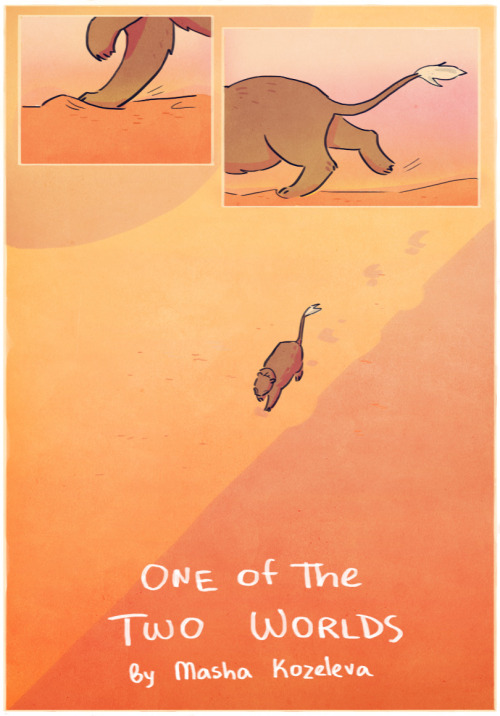
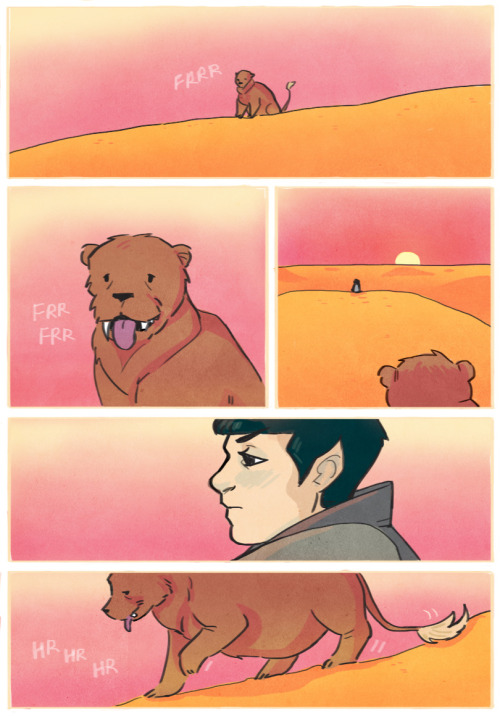
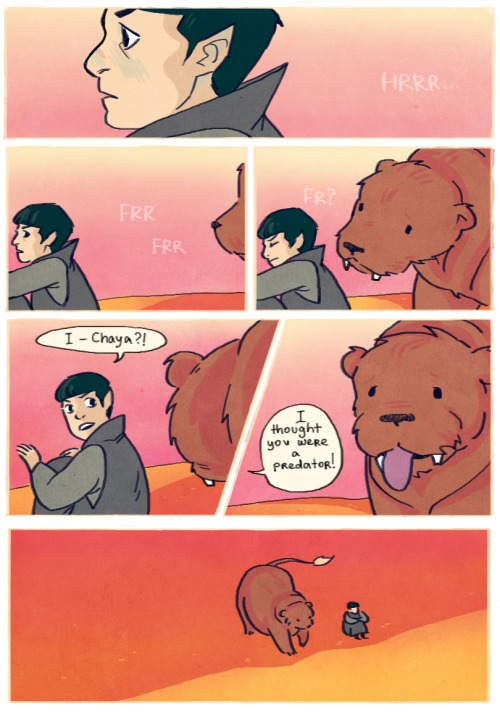
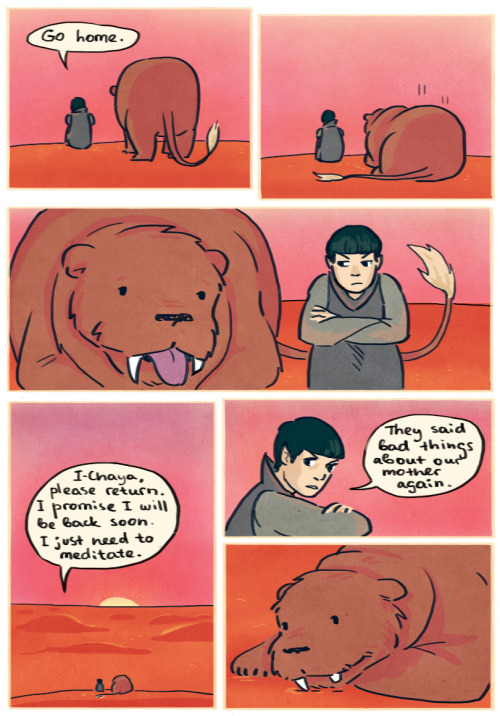
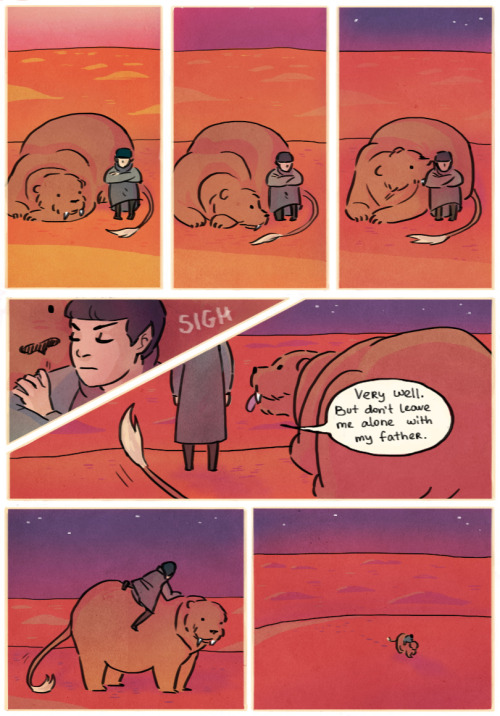
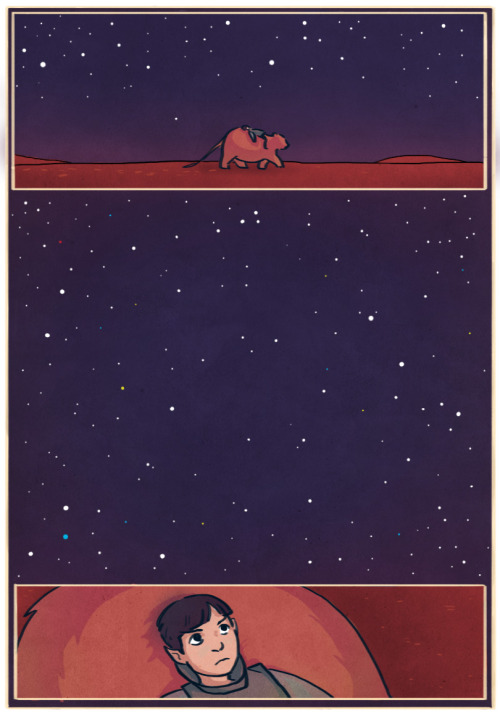
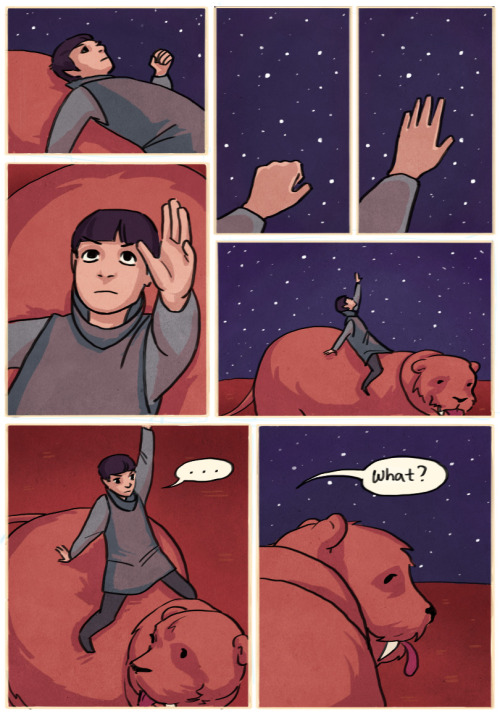
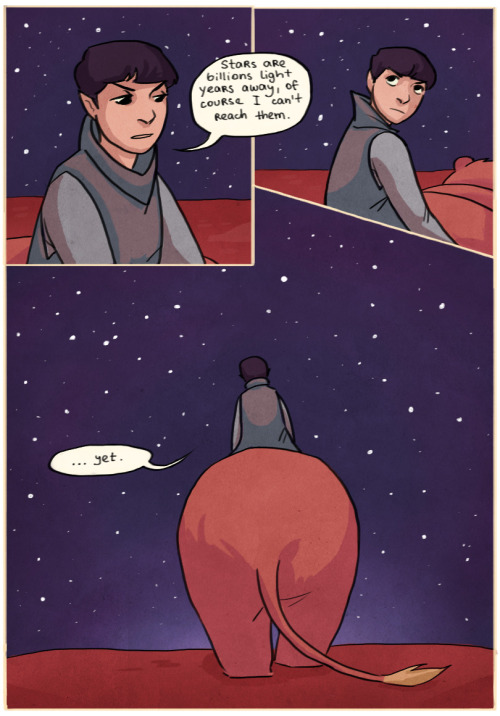
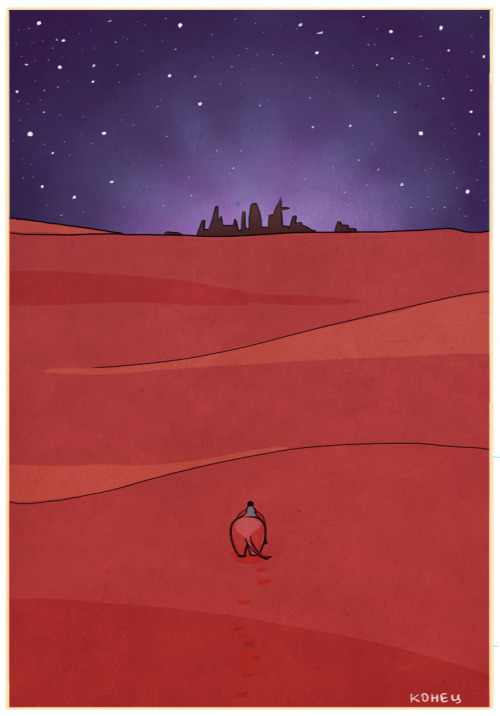
AT LAST, the full comic! I won the comics competition at UniCon with it :) they gave me a fancy award made of glass
This clip 😭😭😭🩷
I'm only half way through so ill add more as I find them but the star trek book Shadows Have Offended by Cassandra Rose Clarke is good but these make it even better









I bring you: my attempts at getting used to drawing on this iPad
It is logical to serve looks: traditional Vulcan clothing.
Traditional Vulcan clothing normally consists of several layers of robes in contrasting earth and jewel tones. Sashes are often worn with robes, but are not commonly worn with shorter shirts. The materials used are mostly natural, like tugno’t or sha'amii wool. Dr'thelek silk, which is not produced or sold outside Vulcan, is traditional for formal gear; however, younger Vulcans favour lighter materials, like Tholian silk. Clothing is cut pretty much the same for men and women, and gender is not typically indicated by style.
Did you know there are actually many words in the Vulcan language to designate specific styles of robes? I have compiled a vocabulary list with some traditional Vulcan clothing items that don’t quite translate with the same degree of precision into English:
ROBES AND SASHES
Beyip: a light robe, often worn under other robes, or over a ne’ahn. The front wraps left over right and is attached on the right side with knotted buttons or with electrostatic seams. Worn as casual wear for business or other activities. May be worn with a casual sash or a mos’opelal if necessary for warmth.
Mos’opelal: A “soft” or light version of the more formal opelal, worn on less-formal occasions.
Si’pelal: an outer, sleeved robe, usually of heavier and elegant fabric, worn over the beyip and under the opelal in more formal ocassions, and always worn with a sash.
Opelal: a heavy “honorable robe” (formal robe), often with broad shoulders, loose sleeves, and a wide hood, worn open at the front to show a contrasting si’pelal. Often, “Rata Tafar Tapan” is embroidered on the right lapel of this garment, specially if the wearer has completed Kolinahr.
Osan-wun: Formal sash, typically consisting of two or three bands, each a bit wider than a typical sash. The ends of a sash can normally be worn long, sometimes nearly to the ground, but in formal occassions that call for the use of an osan-wun, stylized knots are used to keep the ends closed and flat against the sash.

Pel-ahn: A light ankle-length garment, typically with long sleeves and often worn as casual everyday dress. It also crosses left over right and fastens at the right shoulder. Typically not worn with a sash. It is looser and more utilitarian than a beyip. A version that extends only to the hips and is worn with trousers also exists and is called a sav-ahn.

Pel-pen: Medium-length robe, wrapped left to right and fastened on the right side with several buttons. Typically knee-length with wide half- or ¾-sleeves and belted about the waist with a sash or belt. Can be worn with trousers or not.
M’ai-wem: a long-sleeved, floor-length dress, often worn with a light opelal. Similar to a pel-ahn, but more close-fitting.
Pi’to-sai: Small cloak. A light cross between a robe and a cloak, typically worn over a beyip, pel-ahn or m’ai-wem.

Salan-sai: A “cloak of breezes.” A sheer, draped, sleeveless garment, open or lightly fastened at the front, worn casually around the house on hotter days. Often brightly-colored and patterned. More formal versions are normally white and worn for ritual functions by lesser celebrants and called y’osalan-sai.

To-pen: A short cape, normally with a hood and wide lapels which extend below the lower edge in front.

To-sai: A cloak, typically calf- or floor-length, with a hood and openings at the sides to allow the arms to pass through. Similar to an opeleal, but more casual and seldom made of costly fabric.

Tipan-dosh: A ritual vestment, consisting of a strip of heavy fabric, shoulder-width or slightly broader, with a hole in the middle for the head. Some come to a point. A tipan-dosh is worn over the y’osi’pelal.

Ak’shem-ai: a traditional bodysuit. Can be worn by itself or under a y’osalan-sai.

Tipan-zhvi: A ritual vestment rather like a rationale, worn across the shoulders and draped down the front and back. Often with cut-outs to reveal the y’osi’pelal (ritual si’pelal) beneath.

To-pal-el: A light jacket of hip- or thigh-length, open at the front and not typically worn closed. Usually has a high collar. A generally utilitarian piece of clothing worn for everyday use. A similar garnment is the pel-pen-zh’e, which does fasten (usually in the middle), is often sleeveless, and it’s cut on the sides to show the trousers worn beneath.
Abru’sav-el: a shirt which is drawn on over the head and has no seams or fastenings. Typically has long sleeves, but versions with short sleeves do exist.
Pel-el: A shirt that wraps across the front, left over right, like a robe, and typically covers the tops of the thighs. It is worn with trousers and occassionally a mos-opelal and/or a light sash as casual “business-wear.”

Pi’mal-kan: A child’s short pants, similar to briefs. Sometimes worn with a pi’san (child’s sash), worn as a baldric across the chest, and carrying family and school markings (shasu’buhk).

ACCESSORIES
Kuvor-talk: a simple closed cap that covers the back of the head, with cheek pieces cut high to expose and highlight the ears.
Ozhup’ai: ceremonial crown worn by officials for highly-formal events
Patam-puna-ti: a type of shawl covering the head and shoulders, typically worn close to the hair.

Patam-wun: a cloth wrapped around the forehead, typically bound at the back with an elaborate knot.
Patem-sai: a type of traditional hat worn throughout vulcan society, though its use is waning outside of ceremonial occasions.

Tark-oyel: “Star coronet”. Worn at many ceremonial events, the the two horn-like shapes represent the red and the white stars visible in the Vulcan sky.

Y’svit azh’wein: a ritual mask that covers the nose and mouth, used only during ceremonies by certain celebrants, such as honor guards. It is derived from an ancient desert mask designed to protect the nose and mouth from dust.

Zhup’ai: a type of hat worn for formal events or as a craftsman’s traditional clothing.

Ut’talu: Interestingly, Vulcan has two words for “necklace”. An ut'talu is solid and torque-like, as opposed to a vik'talu, which is a pendant hanging on a chain or cord. By the way, the most widely used stone in Vulcan jewelry is rubinite, as it’s very common in Vulcan.

UNDERWEAR
Ash’ai-kuv: a kind of garter typically worn above the knee, usually with some form of ritual symbol or markings. Worn under the clothing by religiously-minded Vulcans.
Ash-wu: a high sock or stocking that typically covers up to the upper thigh. These are worn almost entirely for formal and ceremonial occassions.
Ne’ahn: under robe, often with ¾ sleeves, white or pale-toned and ankle-length. Often has a high collar which can be seen above the collar of a beyip or pel-ahn.
Ne’ak’shem: a type of short bodysuit or leotard used as underwear. It is elastic, close-fitting and has no fastenings. Some Vulcans prefer it instead of Terran-style underwear.
Pi’toh: a type of loincloth consisting of rectangular panels and a cord to tie it in place. It has currently fallen out of fashion and is only worn for certain ceremonial purposes or by very traditional Vulcans, but it appears often in depictions of pre-Surakian times.
Sources: VLD, VLRP, Hidden Universe Travel Guides: Star Trek: Vulcan, Christies, Purple Sloth, ENT, TAS, ST: TMP, ST: Beyond, ST: SFS, ST: FC, STO.

the severance season 2 speedy squad of six
This clip 😭😭😭🩷





Recent sketchbook pages!
THIS ART IS SO CUTE WE LOVE CHARACTER DUOS WITH OPPOSING DESIGNS!!!!!!!!!!!!!!!!!!!!!!!!!!!!!!!!!!!!!!!!!!!!!!!!!!!!!!!!!!!!

ocs as gym leaders in pokemon
left: flying specialization, with a tera flying espathra
right: water specialization, with a tera water klawf
-
 theinevitablewing reblogged this · 6 days ago
theinevitablewing reblogged this · 6 days ago -
 cybrange liked this · 1 month ago
cybrange liked this · 1 month ago -
 lamentfishdespair liked this · 1 month ago
lamentfishdespair liked this · 1 month ago -
 aihaloos liked this · 2 months ago
aihaloos liked this · 2 months ago -
 i-archmybacula liked this · 2 months ago
i-archmybacula liked this · 2 months ago -
 fallofthecelestial reblogged this · 2 months ago
fallofthecelestial reblogged this · 2 months ago -
 tobytheeggo liked this · 3 months ago
tobytheeggo liked this · 3 months ago -
 barloten liked this · 3 months ago
barloten liked this · 3 months ago -
 chainsofother reblogged this · 3 months ago
chainsofother reblogged this · 3 months ago -
 chainsofother liked this · 3 months ago
chainsofother liked this · 3 months ago -
 bloodvaine liked this · 4 months ago
bloodvaine liked this · 4 months ago -
 kcat31 liked this · 5 months ago
kcat31 liked this · 5 months ago -
 psychology-department liked this · 5 months ago
psychology-department liked this · 5 months ago -
 seb1stan liked this · 5 months ago
seb1stan liked this · 5 months ago -
 itslazi liked this · 5 months ago
itslazi liked this · 5 months ago -
 kodykoi liked this · 5 months ago
kodykoi liked this · 5 months ago -
 jesterward reblogged this · 5 months ago
jesterward reblogged this · 5 months ago -
 jesterward liked this · 5 months ago
jesterward liked this · 5 months ago -
 shakalakakaka liked this · 5 months ago
shakalakakaka liked this · 5 months ago -
 pixelatedbugs reblogged this · 5 months ago
pixelatedbugs reblogged this · 5 months ago -
 pixelatedbugs liked this · 5 months ago
pixelatedbugs liked this · 5 months ago -
 the-bitter-ocean reblogged this · 5 months ago
the-bitter-ocean reblogged this · 5 months ago -
 the-bitter-ocean liked this · 5 months ago
the-bitter-ocean liked this · 5 months ago -
 thelostsheepp reblogged this · 6 months ago
thelostsheepp reblogged this · 6 months ago -
 thelostsheepp liked this · 6 months ago
thelostsheepp liked this · 6 months ago -
 minted-eye liked this · 6 months ago
minted-eye liked this · 6 months ago -
 captaincanonly liked this · 6 months ago
captaincanonly liked this · 6 months ago -
 moldynomadmain liked this · 6 months ago
moldynomadmain liked this · 6 months ago -
 staarbles liked this · 6 months ago
staarbles liked this · 6 months ago -
 pinyatapix liked this · 6 months ago
pinyatapix liked this · 6 months ago -
 theicyboi liked this · 6 months ago
theicyboi liked this · 6 months ago -
 marlowes-posts liked this · 7 months ago
marlowes-posts liked this · 7 months ago -
 rorschach-black liked this · 7 months ago
rorschach-black liked this · 7 months ago -
 minty-the-magic-man reblogged this · 7 months ago
minty-the-magic-man reblogged this · 7 months ago -
 minty-the-magic-man liked this · 7 months ago
minty-the-magic-man liked this · 7 months ago -
 shiroace liked this · 7 months ago
shiroace liked this · 7 months ago -
 damn4tt liked this · 7 months ago
damn4tt liked this · 7 months ago -
 dxntbreathein liked this · 7 months ago
dxntbreathein liked this · 7 months ago -
 palarie liked this · 7 months ago
palarie liked this · 7 months ago -
 voyagerscompass reblogged this · 7 months ago
voyagerscompass reblogged this · 7 months ago -
 munogie liked this · 7 months ago
munogie liked this · 7 months ago -
 arlina-jjba reblogged this · 8 months ago
arlina-jjba reblogged this · 8 months ago -
 arlina-jjba liked this · 8 months ago
arlina-jjba liked this · 8 months ago -
 jesterjackbox liked this · 8 months ago
jesterjackbox liked this · 8 months ago -
 crype150 liked this · 8 months ago
crype150 liked this · 8 months ago -
 makoakira reblogged this · 8 months ago
makoakira reblogged this · 8 months ago -
 makoakira liked this · 8 months ago
makoakira liked this · 8 months ago -
 sel-kou-th liked this · 8 months ago
sel-kou-th liked this · 8 months ago -
 taphwa liked this · 8 months ago
taphwa liked this · 8 months ago -
 vanillarbeam reblogged this · 8 months ago
vanillarbeam reblogged this · 8 months ago

I was gonna make this obnoxiously long but Tumblr didn;t let me :(
135 posts